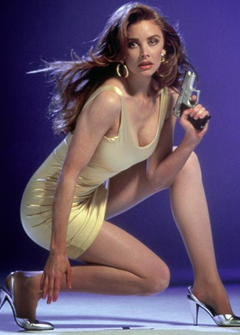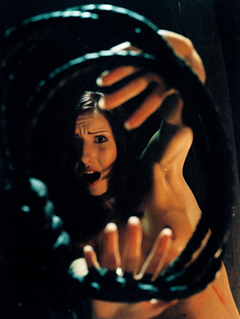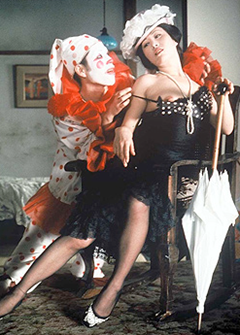Walk up to anyone who owns an expensive sports car and ask them what kind of engine is under the hood, there's a good chance you'll be getting a guided tour of said engine mere moments after the question was asked. The desire to show off the complicated apparatus that helps propel their vehicle is something that lies within almost every driver on earth. However, what if your engine doesn't contain an intake manifold, a Johnson rod or spark plugs? What if your car has a vampire instead of an engine? And in place of gasoline, it uses blood, your blood. Do you mean there's a vampire living underneath the car's hood, or do you mean the actual car is a vampire? I'm not sure. It could be a metaphor for soaring gas prices. But then again, I've never purchased gas. Though, I've heard the sensation one feels after filling up their tank with gas is akin to feeling as if you have been sucked dry. The manufactures of the Škoda Super Sport 1100 in Ferat Vampire (a.k.a. Der Autovampir), a deeply weird film about a car that may or may not be a bloodthirsty vampire, don't want you to know what's under their hood. A veiled attack against capitalism, an ironic jab at the ridiculousness that is the automobile industry, and an inspirational tale of a nerdy doctor who gets more Czechoslovak tail than the display only bidet at your local Bed Bath and Beyond, director Juraj Herz (Morgiana) takes his bizarre premise and runs with it; well, "drives with it," is more like it, as there's not much running in this film. Is all this an elaborate rouse to drum up interest for Ferat's prototype sports car, or is there something truly sinister going on? Interesting question. In fact, I'm surprised you were able to pick up on the film's satirical tendencies. Are you sure you didn't just read someone else's take on the film and are currently trying to pass it off as your own? No, I'm afraid this all me.
You know how they say, "any publicity is good publicity." Well, the makers of the car at the centre of this odd undertaking seem to be hedging their bets on that concept, as the publicity mad company seem to be encouraging the wild speculation that is swirling around their product.
I've often wondered, how many times a day does your average ambulance driver think to his or herself that they could easily make the transition from driving ambulances to driving rally cars? No, seriously. I've often wondered that. Well, at the beginning of Ferat Vampire (a.k.a. Upír z Feratu), a blonde ambulance driver named Mima (Dagmar Veškrnová-Havlová) seems to think she can do just that. Of course, it doesn't hurt that she used to be a race car driver before her ambulance driving days. But still, driving ambulances and driving rally cars aren't quite the same thing. For starters, ambulances are slow and clunky compared to rally cars, which are specially built road-legal cars. Also, you need to have nerves of steel to drive rally cars professionally.
Actually, now that I think about it, ambulance drivers are perfectly suited for rally car racing. And it would seem that the makers of a new car by Ferat, a German motor company, think this as well. How else can you explain the strange events that occur on a rural road just outside of Prague? Driving her ambulance, along with Dr. Marek (Jirí Menzel), Mima is hounded by the prototype for Ferat's latest car. After the Ferat disappears, Mimi and Dr. Marek realize the address they were called to doesn't exist, and start to wonder who would do such a thing. Suddenly, the black Ferat reappears. Opening the car's unique door (both its doors and windshield are pushed up), the curly-haired driver of the Ferat, Luisa Tomášová (Jana Brezková) sticks her legs out and awaits Mima and Dr. Marek. Since she's obviously still steamed about almost being run off the road, Dr. Marek suggests that he do most of the talking.
Telling the bespectacled doctor that there's something wrong with her foot, Luisa shows Dr. Marek a foot that is covered in contusions. As Dr. Marek is examining Luisa's foot, Mima decides to sit in the Ferat. Playing her foot on the accelerator, Mima can't help but notice that it's oddly shaped; she even points it out to Dr. Marek.
Advising her to rest her feet, Dr. Marek and Mima hop back in their ambulance and drive off. Call me crazy, but there was something not right about Dr. Marek and Mima's encounter with Luisa. The situation gets even more not right moments later when Dr. Marek and Mima come across Luisa's Ferat turned over on the side of the road. Being a doctor and all, Dr. Marek tries to aid Luisa, who looks like she's been injured. The key word there being "tries," as another ambulance, the media, and members of Team Ferat are already at the scene. How did all these people know that Luisa's car had crashed so quickly? Shoved aside by the throng of reporters and the fleet of Ferat employees (you can spot the people who work for Ferat by their distinctive red and black uniforms), Dr. Marek is helpless to stop Luisa from being carted away in this other ambulance.
Meanwhile, back at Ferat headquarters, Madame Ferat (Zdenka Procházková) and her gang of leather-clad sycophants are reviewing the tapes of the event that occurred at the side of the road. When Dr. Marek appears onscreen to tell the reporters that there's something wrong with the car Luisa was driving, the room grows quiet. What interest could Ferat have in a nondescript doctor who pines over an ambulance driver. Speaking of which, has anyone seen Mima? The last time I saw her she was getting in a car with one of those Ferat assholes; I think it was a guy named Kross (Petr Čepek, the moderately handsome lawyer from Morgiana). Either way, I'm worried about her.
Akin to the paranoid thrillers that littered the cinematic landscape of the 1970s, with, of course, a touch of David Cronenberg thrown in there for good measure, Ferat Vampire is many things: A horror film with science fiction overtones. A satire of mindless consumerism. But it's also an attack on driving. Think about it. Driving is one the most unnatural activities the human body partakes in during the modern era. A morgue employee, one who apparently performed the autopsy on Luisa Tomášová, informs Dr. Marek that spinal cords and automobiles don't mix. In other words, people's bodies aren't equipped to handle the trauma that can be inflicted by a car in motion. Anyway, when Dr. Marek goes to look at Luisa's body, it's missing. Which is too bad, because according the morgue employee, her foot appeared as though it had been bitten off.
If the mild-mannered doctor's imagination wasn't already going into overdrive, a "scientist" named Kaplan (Jan Schmid) makes sure it is when he starts filling Dr. Marek's head with all sorts of outlandish nonsense. The kicker being that Ferat's cars run on human blood. Arguing that the fine folks at Ferat have made an startling advancement in the field of biological machinery, Kaplan basically tells him that their car kills all those who drive it.
In an attempt to convince him that his theory is sound, Kaplan shows Dr. Marek an old vampire movie. While not the most common method to persuade someone into thinking there's a car out there that runs on human blood, it makes sense that a company would want its customers to become addicted to their product. You see, once the car gets a taste of your blood, you will find that you won't be able to stop driving it. Which is exactly what happens to Mima, who has apparently signed a contract to be Ferat's newest test driver. This causes Dr. Marek to become more determined than ever to unveil the truth, as he cares deeply for Mima. And why wouldn't he? She's freakin' adorable.
Still curious to know what happened to Luisa Tomášová (he would really like to know if her foot was in fact bitten off like the morgue guy said it was), Dr. Marek heads to the church where Luisa's coffin is lying in state. Finding an empty coffin filled with dirt, Dr. Marek meets Luisa's twin sister Klára Tomášová. Also curious to know what happened to Luisa, Klára and Dr. Marek decide to share resources. And, of course, have sex.
I don't know how Dr. Marek managed to pull this off, but watching him score with the ladies was inspirational. Only problem being that both his sexual encounters in Ferat Vampire end with him being covered with blood. Don't ask.
At the end of the day, we all, sooner or later, become whores to capitalism. And Dr. Marek is no different. Signing a deal for 60, 000 korunas, Dr. Marek is told by Ferat to write an article about their car. Now, I don't know what Ferat are up to, but Dr. Marek simply wants to get close to the car. Which the contract he signs allows him to do. In the film's most memorable, non-leg crossing scene, Dr. Marek approaches the car in the Ferat showroom (a slick space filled with neon and smoke). Noticing that the car seems to be breathing (its hood throbs same way the television set does in Videodrome), Dr. Marek puts his hand inside. And, well, let's just say, things get a little messy.
Did you just say, "non-leg crossing scene"? Oh, yeah, the leg crossing scene. Oh my god, can you believe that I almost forgot to examine this scene? During one of the many conversations that take place between Klára Tomášová and Dr. Marek, Klára decides to sit down on the couch. And as her ass is hitting the cushion, she completes the sitting down process by crossing her legs in a forceful manner. Unwittingly creating the Czech leggy moment to end all Czech leggy moments, one that oozed an untoward amount of Czech legginess, Klára realizes that she might have overplayed her leggy card (all Czech women have this card in their corporeal deck of cards) and quickly covers her crossed legs with the material attached to the bottom half of her robe.
Obviously having seconds thoughts about her leg-based sheepishness, Klára Tomášová chooses to re-implement her legginess moments later while sitting on a small bookshelf. While not as forceful or in your face as the couch display, Klára Tomášová makes it clear that her legs are in total control of the situation. And judging by Dr. Marek's crumpled demeanour, they're definitely that...in total control.
A pleasant surprise, in that, I had no idea Czechoslovak cinema was still being weird and fanciful into 1980s, Ferat Vampire makes a mockery of the advertising industry and the lengths some companies will go to get publicity. Culminating at the Škoda rally, complete with time trials, the truth slowly starts come out. Or does it? Either way, the film, on top of being an excellent showcase for Jana Břežková's Czech legginess and Dagmar Veškrnová-Havlová's cuteness, is a curious slab of Eastern European sci-fi horror. Oh, and did anyone else notice the word "ferat" can be found in the word "Nosferatu"? At any rate, see you at this year's Moscow International Motor Show (Московская Международная Автомобильная выставка).
video uploaded by gregstacamaro









































































Damn. Now I wanna see this one, too. Is November Juraj Herz month? Please?
ReplyDeleteI can't read Czech, so all I can really tell from the Škoda 110 Super Sport Ferat page on Wikipedia is that Škoda Auto made the Ferat model on in 1971 only. The it looks like the Super Sport 110 was made from '69-'71.
Its odd, because this film is ten years plus AFTER that single production year for the Ferat model. I wonder if Herz or whoever wrote the screenplay had the vampire car idea, and production said, "Hey! Remember ten years ago when they made that vampire looking sports car? We should totally one. Wait a minute, I wonder if we could get the manufactures to finance the film!" Škoda has a long long history of auto sports in Europe, especially rally racing.
Again, according to trying to guess from Czech wikipedia, the Ferat model was only in production for a single year. In sports car terms this means one of two things:
1) a limited edition special model displaying the company's top tech. 2) A complete and total engineering failure that results in a financial disaster for the company.
The Super Sport 110 line looks hot, but it also looks like it was cobbled together from Ferrari pieces that were laying around and glued together. The Ferat probably was a true vampire on the finances of its owners.
So Škoda would have liked the idea of having their forgotten vampire car in a movie, not thinking that it might turn out to be a subversive affair. I wonder if they were in the production credits for the cars, the final race sequence, etc.
That's just my guess work. If anyone can actually read Czech, please correct me.
The whole company involvement in this thing is extremely interesting. In the States, especially these days, you see non-stop corporate whoring in mainstream film. But nothing like "take our ten year old out-modeled sports car and make it a parasite. Oh, and we are the ones who engineered it like that, so you'd want it that way!" Unless you are David Cronenberg, and Canadian.
Hey,
DeleteI don't suppose you care anymore, but I was just searching if "Ferat Vampire" is known abroad and saw your comment.
The car, Škoda 110 Super Sport (type 724), like you implied, is a prototype which never made it into serial production. Before "Ferat Vampire", it appeared in 1977 movie "Tomorrow I'll Wake Up and Scald Myself with Tea" though – with original white color. An artist Theodor Pištěk later redesigned it for "Ferat Vampire" (it was painted black, the lights were taken from Škoda 742 M...). Nowadays, the car is displayed at the museum in Mladá Boleslav.
I don't know what was Škoda's stance, but I suppose they didn't care about negative advertising, there were like three types of cars available at the time anyway. 1982 is a part of the era of normalization (= return to hardcore socialism) in Czechoslovakia, and both the mentality of people and market options were very different.
Four years later....
DeleteThank you for the info! I'm actually a lot more into motorsports now and find the 1980s Group B era of rallying especially insane. Although this car wasn't part of that, its still an interesting concept.
Maybe Škoda was just happy to have their prototype in a film. I don't think they've ever been known for performance models and the thing looks fucking badass.
I'm afraid November is not Juraj Herz month. :(
ReplyDeleteOn the other hand, I hope you enjoyed Juraj Herz week. :)
I just took a quick look-see at the Škoda 110 Super Sport Wikipedia page, and, I must say, I'm as flummoxed as you are. Okay, maybe I'm not that flummoxed (I like the word "Škoda"), but I am definitely bewildered.